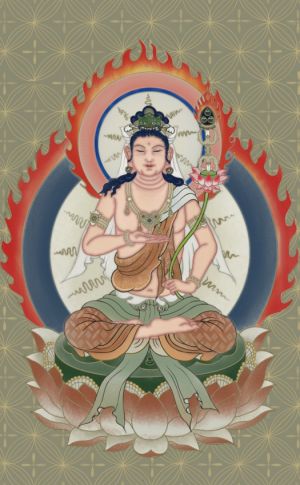Ratnapāṇi
Ratnapāṇi (रत्नपाणि) is the name of a Bodhisattva mentioned as attending the teachings in the 6th century Mañjuśrīmūlakalpa: one of the largest Kriyā Tantras devoted to Mañjuśrī (the Bodhisattva of wisdom) representing an encyclopedia of knowledge primarily concerned with ritualistic elements in Buddhism. The teachings in this text originate from Mañjuśrī and were taught to and by Buddha Śākyamuni in the presence of a large audience (including Ratnapāṇi).
1) Ratnapāṇi (रत्नपाणि) is the name of the Bodhisattva offspring associated with Ratnasambhava: one of the Dhyāni-Buddhas, according to Vajrayāna or Tantric Buddhism.
His colour is yellow; and his symbol is the jewel.—Ratnapāṇi, as the name signifies, belongs to the Ratnakula which is presided over by the Dhyāni Buddha Ratnasambhava, whose spiritual consort is Vajradhātvīśvarī. Ratnapāṇi is of the same nature as the Dhyāni Buddha and when represented, he either stands erect, or sits in different sitting postures.
He holds the stalk of a lotus on which appears the Kula symbol which is here the Jewel (Ratnacchaṭā). He is represented sparingly in the Buddhist Countries of the North, and a metal image of his found in Nepal [...]. Ratnapāṇi is known and represented in Tibet.
2) Ratnapāṇi (रत्नपाणि) is the name of a Bodhisattva commonly depicted in Buddhist Iconography, and mentioned in the 11th-century Niṣpannayogāvalī of Mahāpaṇḍita Abhayākara. —his color is green; his symbol is the jewel or the moon. —Ratnapāṇi is the Bodhisattva of the Dhyāni Buddha Ratnasambhava and as such, he is sometimes represented in Nepal and Tibet. His image is not found in the Chinese collection.
Ratnapāṇi is described in the Niṣpannayogāvalī (Dharmadhātuvāgīśvara-maṇḍala) as follows:—
“Ratnapāṇi is green in colour, holds the jewel in the right hand, and the disc of the moon on lotus in the left hand”.
3) Ratnapāṇi (रत्नपाणि) or Ratnapāṇilokeśvara refers to number 47 of the 108 forms of Avalokiteśvara found in the Machhandar Vahal (Kathmandu, Nepal). Machhandar or Machandar is another name for for Matsyendra..
“Ratnapāṇi also is identical with [[[Avalokita]] Lokeśvara] in all respects, except that he holds the sword in his left hand and displays the Varada mudrā with his right.—Avalokita Lokeśvara also is one-faced and two-armed and sits in the same attitude on a lotus. He wields the sword in his right hand and holds the stem of a lotus against the chest with his left”.
The names of the 108 deities [viz., Ratnapāṇi possibly originate from a Tantra included in the Kagyur which is named “the 108 names of Avalokiteshvara”, however it is not yet certain that this is the source for the Nepali descriptions.
Tibetan Buddhism includes schools such as Nyingma, Kadampa, Kagyu and Gelug. Their primary canon of literature is divided in two broad categories: The Kangyur, which consists of Buddha’s words, and the Tengyur, which includes commentaries from various sources. Esotericism and tantra techniques (vajrayāna) are collected independently.
Ratnapāṇi (रत्नपाणि).—name of a Bodhisattva: Mahāvyutpatti 655; Saddharmapuṇḍarīka 3.5; (Ārya-)Mañjuśrīmūlakalpa 425.19; Kāraṇḍavvūha 1.12; 17.1, etc. (plays prominent rôle in Kāraṇḍavvūha).
1) Ratnapāṇi (रत्नपाणि) as mentioned in Aufrecht’s Catalogus Catalogorum:—Ṣaṭkārakapratichandaka [grammatical]
2) Ratnapāṇi (रत्नपाणि):—son of Acyuta, father of Ravi (Kāvyaprakāśaṭīkā): Kāvyadarpaṇa.
Source: Cologne Digital Sanskrit Dictionaries: Monier-Williams Sanskrit-English Dictionary
1) Ratnapāṇi (रत्नपाणि):—[=ratna-pāṇi] [from ratna] m. Name of a Bodhisattva, [Monier-Williams’ Buddhism 203]
